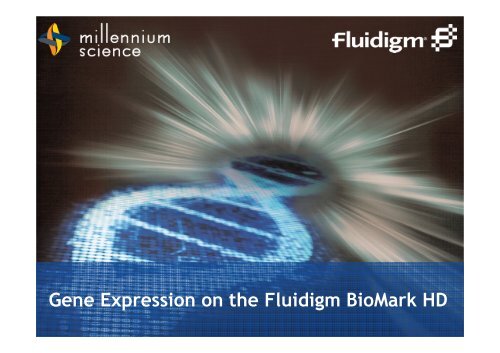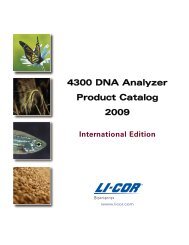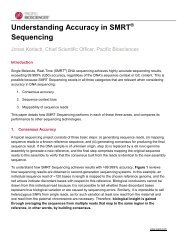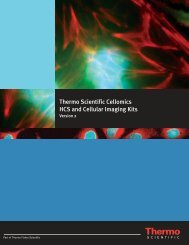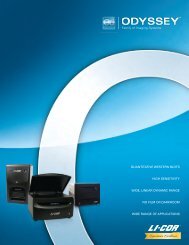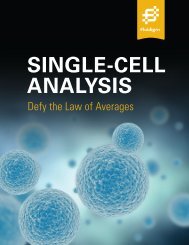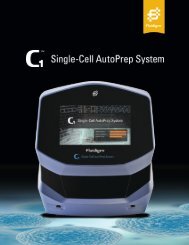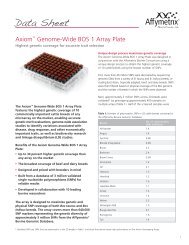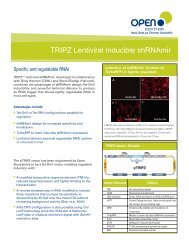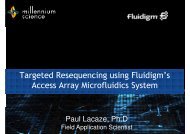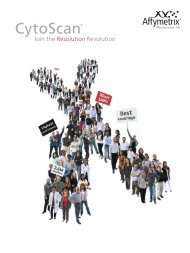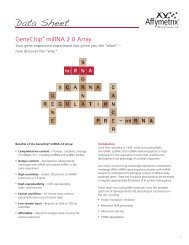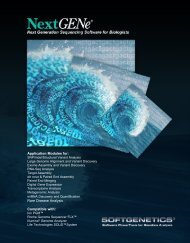Gene Expression on the Fluidigm BioMark HD
Gene Expression on the Fluidigm BioMark HD
Gene Expression on the Fluidigm BioMark HD
You also want an ePaper? Increase the reach of your titles
YUMPU automatically turns print PDFs into web optimized ePapers that Google loves.
<str<strong>on</strong>g>Gene</str<strong>on</strong>g> <str<strong>on</strong>g>Expressi<strong>on</strong></str<strong>on</strong>g> <strong>on</strong> <strong>the</strong> <strong>Fluidigm</strong> <strong>BioMark</strong> <strong>HD</strong>
Overview<br />
• Introducti<strong>on</strong> to <strong>Fluidigm</strong> James Miller<br />
• Advantages of <strong>the</strong> technology<br />
• Running a <strong>Fluidigm</strong> gene expressi<strong>on</strong> project Paul Lacaze<br />
• Assay design, chemistry, experimental workflow<br />
• Data analysis<br />
• Case study – miRNA expressi<strong>on</strong> in plasma<br />
• Scientific Applicati<strong>on</strong>s Talk Chris Hanh
<strong>BioMark</strong> <strong>HD</strong> Real-Time PCR System<br />
High-throughput qPCR based microfluidic technology for DNA,<br />
RNA, miRNA analysis and next-gen library prep
Technology
Advantages of <strong>Fluidigm</strong><br />
Automate thousands of individual<br />
PCR reacti<strong>on</strong>s<br />
Greatly decrease number of<br />
pipetting steps<br />
Decrease amount of sample and<br />
reagent used
1,300
Outline
Dynamic Arrays: <str<strong>on</strong>g>Gene</str<strong>on</strong>g> <str<strong>on</strong>g>Expressi<strong>on</strong></str<strong>on</strong>g><br />
96.96<br />
48.48<br />
9,216 data points 2,304 data points
Open Nanoflex Valve<br />
Fluid Line<br />
C<strong>on</strong>trol Line
Closed Nanoflex Valve<br />
Fluid Line<br />
C<strong>on</strong>trol Line<br />
Fluid Line
<str<strong>on</strong>g>Gene</str<strong>on</strong>g> expressi<strong>on</strong> applicati<strong>on</strong>s<br />
Microarray Validati<strong>on</strong> Large Patient Cohorts<br />
Transcriptome Sequencing Validati<strong>on</strong>
When is <strong>Fluidigm</strong> <strong>the</strong> best time choice for<br />
<str<strong>on</strong>g>Gene</str<strong>on</strong>g> <str<strong>on</strong>g>Expressi<strong>on</strong></str<strong>on</strong>g>?<br />
Many samples (batches of 24, 48, 96 samples)<br />
Easy workflow and quick time to result<br />
Flexibility of assay selecti<strong>on</strong><br />
Ideal for 20-200 genes<br />
qPCR vs Microarrays/RNA-seq<br />
- qPCR is more sensitive, higher dynamic range<br />
- qPCR is often required for validati<strong>on</strong><br />
- qPCR gives more rapid result, easier analysis
http://www.biomedcentral.com/1471-2164/12/144<br />
"<strong>Fluidigm</strong> uses <strong>the</strong> quantitative PCR assays which are<br />
highly sensitive with a dynamic range of at least 6-7<br />
logs [19,22] .<br />
The dynamic range of <strong>the</strong> microarray is usually 3 to 4<br />
logs [25,26] . In our hands, <strong>the</strong> maximum fold change<br />
observed was around 3 for microarrays and 13 for<br />
<strong>Fluidigm</strong> dynamic array."
<strong>Fluidigm</strong> <str<strong>on</strong>g>Gene</str<strong>on</strong>g> <str<strong>on</strong>g>Expressi<strong>on</strong></str<strong>on</strong>g> Chemistry Opti<strong>on</strong>s
Text box<br />
96 cDNA Samples<br />
(Diluted STA product)<br />
Workflow<br />
9,216 PCR reacti<strong>on</strong>s<br />
96 Assays<br />
(primer pairs)
96<br />
Samples<br />
C t heat map<br />
96 genes<br />
C t
96 Samples<br />
Fold-change heat map<br />
96 genes<br />
C t
<strong>Fluidigm</strong> <str<strong>on</strong>g>Gene</str<strong>on</strong>g> <str<strong>on</strong>g>Expressi<strong>on</strong></str<strong>on</strong>g> Project Workflow<br />
Assay design<br />
- Taqman vs EvaGreen<br />
- Pre-existing vs new primers<br />
Order chips and reagents<br />
Reverse Transcribe and PreAmplify samples<br />
Run <strong>Fluidigm</strong> chips<br />
Analyse data
<str<strong>on</strong>g>Gene</str<strong>on</strong>g> <str<strong>on</strong>g>Expressi<strong>on</strong></str<strong>on</strong>g> Experimnetal Workflow<br />
Assay design<br />
Reverse Transcripti<strong>on</strong><br />
STA cDNA<br />
Prepare<br />
reagents<br />
and pipet<br />
into chip<br />
Load chip<br />
qPCR <strong>on</strong><br />
<strong>BioMark</strong><br />
Analyze<br />
data
Chemistry<br />
EvaGreen (SYBRGreen) vs Taqman
Standard EvaGreen ® Chemistry<br />
Denature<br />
Binds to ANY double stranded DNA target<br />
i.e. NOT sequence specific<br />
Anneal/Amplificati<strong>on</strong>
Melt Curve Following PCR<br />
Heat 65-95<br />
Product Melts at specific<br />
Tm, Dye falls off
Single Amplic<strong>on</strong> = Single T m Peak<br />
GAPDH
Evagreen Pros and C<strong>on</strong>s<br />
• F/R primers with n<strong>on</strong>-specific DNA-binging dye<br />
= More ec<strong>on</strong>omical than Taqman<br />
• Can be pr<strong>on</strong>e to n<strong>on</strong>-specific PCR products<br />
(melt curve required)<br />
• Flexible, easy to change genes in and out
Text box<strong>Fluidigm</strong> custom assay design service
<strong>Fluidigm</strong> DELTAgene ® Assays<br />
• <strong>Fluidigm</strong>-designed primers for genes/panels<br />
• Minimize upfr<strong>on</strong>t cost of assays<br />
• Uses EvaGreen Chemistry<br />
• Amplic<strong>on</strong>s designed to cross an intr<strong>on</strong><br />
• Assays predicted to multiplex well
Taqman Assays
Taqman Assays Pros and C<strong>on</strong>s<br />
• F/R primers with sequence specific probes<br />
• One probe for each target = specificity<br />
• Less likely to have n<strong>on</strong>-specific PCR products<br />
• More expensive<br />
• Easier to use (all in <strong>on</strong>e tube)<br />
• Many people already have <strong>the</strong>m
Specific Target Amplificati<strong>on</strong> (STA)<br />
Multiplex<br />
Primer Pool<br />
(0.2X or 500 nM)<br />
+ +<br />
DNA sample<br />
(low c<strong>on</strong>c)<br />
Preamplified<br />
DNA<br />
Diluti<strong>on</strong><br />
14 cycles<br />
D<strong>on</strong>e in 96 or 384-well plates<br />
“off-chip”<br />
Multiplex PCR<br />
Master Mix
Specific Target Amplificati<strong>on</strong> (STA)
<strong>BioMark</strong> (with STA) has excellent correlati<strong>on</strong> with<br />
<strong>the</strong> 7900<br />
ABI 7900<br />
r= 0.99<br />
<strong>BioMark</strong> (with STA)
Workflow: Fast and Easy<br />
Prime Pipette Load PCR/Scan<br />
10 min 20 min 55/90 min<br />
90/130 min
Key <strong>Fluidigm</strong> Summary Points<br />
• Easy c<strong>on</strong>versi<strong>on</strong> from standard qPCR<br />
- Any chemistry can be used<br />
- Miniaturizati<strong>on</strong> of reacti<strong>on</strong>s<br />
• Samples/assays can be run in replicate to fill <strong>the</strong><br />
48 or 96 inlets<br />
• Minimizes pipetting error and lab time
miRNAs<br />
• RT step is target/miRNA specific<br />
- <strong>on</strong>ly miRNA reverse transcribed<br />
• PreAmp using Megaplex primers or targetspecific<br />
primers<br />
• Lab workflow same as <str<strong>on</strong>g>Gene</str<strong>on</strong>g> <str<strong>on</strong>g>Expressi<strong>on</strong></str<strong>on</strong>g>
Case study – 96.96 IFCs<br />
16 Taqman miRNAs<br />
Assays already in lab<br />
Run in n6 = 96 assays<br />
To be detected in varying levels in plasma<br />
Some expressed at very low levels<br />
23 plasma samples<br />
Candidate early biomarkers of cancer<br />
From cancer vs normal patients<br />
Run in n4, plus 4-point std curve = 96 samples<br />
Assays n6 x Samples n4 = n24 replicates
Cancer<br />
Normal<br />
Cell line<br />
16 miRNA x6
Thank you!<br />
Questi<strong>on</strong>s?<br />
Paul Lacaze<br />
placaze@mscience.com.au
miRNAs
Reproducibility of <str<strong>on</strong>g>Expressi<strong>on</strong></str<strong>on</strong>g> Levels between<br />
<strong>Fluidigm</strong> and ABI 7900 HT<br />
- Tested reproducibility of miRNA expressi<strong>on</strong> by comparing Ct<br />
values between ABI 7900 HT and <strong>Fluidigm</strong><br />
- Mean Ct values between <strong>the</strong> platforms were<br />
<strong>Fluidigm</strong> 12.48 (± 0.49) CV=0.08<br />
ABI 7900 HT 16.21 (± 0.82) CV= 0.06<br />
- “Significant increase in sensitivity by microfluidics when qPCR<br />
reacti<strong>on</strong>s are being carried out in nanoliter volumes”.
Reproducibility of <str<strong>on</strong>g>Expressi<strong>on</strong></str<strong>on</strong>g> Levels between<br />
<strong>Fluidigm</strong> and ABI 7900 HT
<strong>Fluidigm</strong> Project planning (Taqman)<br />
Use existing Taqman assays directly <strong>on</strong> <strong>the</strong> <strong>Fluidigm</strong> system<br />
For each <strong>Fluidigm</strong> IFC inlet, 3ul of Taqman req per gene<br />
Enough to measure expressi<strong>on</strong> from 48 or 96 samples<br />
depending <strong>on</strong> <strong>the</strong> chip format (48.48 or 96.96)<br />
If users have less than 48 Taqman assays, that’s fine. Assays can be<br />
replicated <strong>on</strong> <strong>the</strong> chip as required (12 assays x4, 16 assays x 3 etc).<br />
Empty inlets can also be filled with loading reagent and left blank if<br />
required<br />
Users can use any mastermix that is compatible with Taqman chemistry<br />
(often <strong>the</strong> same MM already in <strong>the</strong>ir lab)


